Day 3 of a long weekend of tours today and it was time to look for Owls. The weather gods were shining on us today – it was a gloriously sunny start to the day, if a little breezy.
After rain overnight and strong winds yesterday, there should normally be some hungry Owls out hunting in the morning. We drove round through some favoured areas first thing, scanning the fields and gate posts, but there was surprisingly no sign of any. We parked up in an area where we know there is a very active pair, but we couldn’t find either of them at first. The favoured fields, the gate posts, all empty.
We decided to take a walk down along the footpath which runs beside the wet grazing meadows. A Little Egret flew up from some wet pools in the trees, causing some momentary excitement in the group – they can sometimes look rather like a Barn Owl in flight from a distance. A Green Woodpecker disappeared away through the trees the way we had come, and a little further along a Great Spotted Woodpecker flew along the hedge the other side towards the woods. A Grey Wagtail came up from the wet ground in front of us.
Then we spotted the Barn Owl. It had flown over to the meadows in the lee of the woods, where it was out of the wind. It flew round briefly and dropped down out of sight. We walked a little further along and it came up again, working its way back and forth over the meadows, before turning back towards us. It flew straight past us on the other side of the meadows, and perched up in a tree in the sun for a few minutes. Then it disappeared back into the ivy to roost, presumably having had some success hunting already.
That was a great way to start, so we made our way back to the car and headed back the way we had come. We hadn’t driven very far when another Barn Owl appeared, over some more meadows just beside the road. We pulled up in a convenient layby and got out, expecting the Barn Owl to continue hunting further over from us. It did at first, but then came towards us and proceeded to fly up and down right in front of us, not 20 metres away. Stunning views in the morning sunshine.
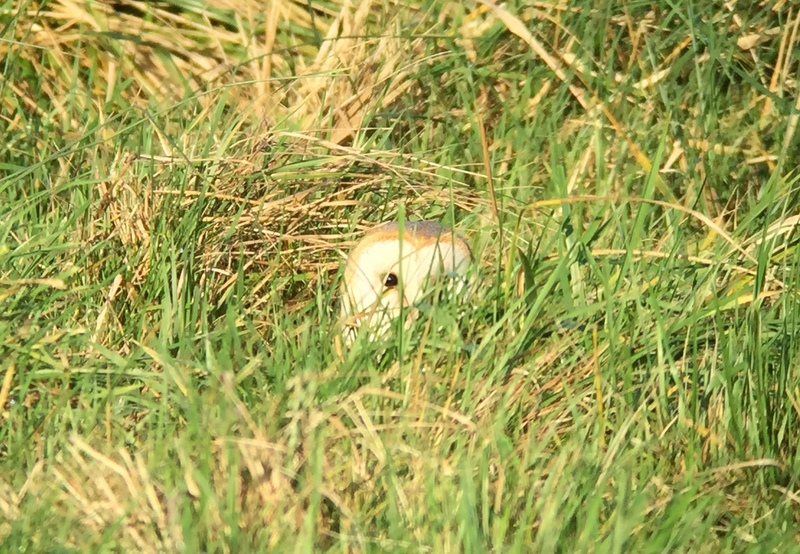 Barn Owl – out hunting in the morning sun
Barn Owl – out hunting in the morning sun
The Barn Owl dropped down into the grass and seemed to be pulling at something – we couldn’t see if it had actually caught anything. It kept looking round nervously and we could see its face looking at us through the vegetation. Then it resumed hunting again. It came round a couple of times, again coming right in front us, seemingly oblivious to our presence, dropping down into the grass again but coming up empty taloned.
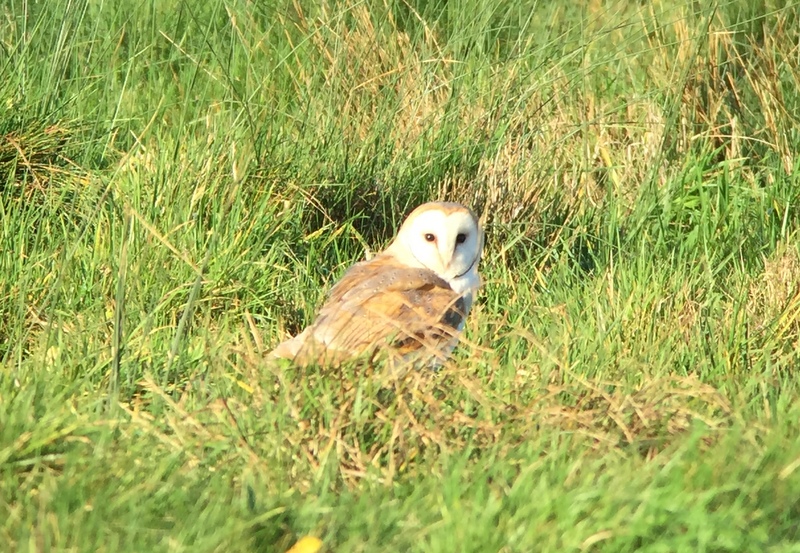 Barn Owl – our second of the morning
Barn Owl – our second of the morning
We stood transfixed, watching it for about 15 minutes, a real treat. Eventually, it moved off and disappeared away through the trees. Two Barn Owls already, and such great views.
It seemed like our luck might be in, so we drove on inland to look for Little Owls next. It was cold in the wind, but at least the sun was out. We came to a complex of farm buildings where we now there is a pair of Little Owls and a quick scan revealed one sitting on the roof of an old shed. It was far enough away that we wouldn’t distub it, so we got out and had a good look at it through the scopes. The Little Owl had found a spot mostly out of the wind and facing the sun. It was quite active, looking round, occasionally hopping back into a more sheltered position, before coming out again onto the roof. Great stuff.
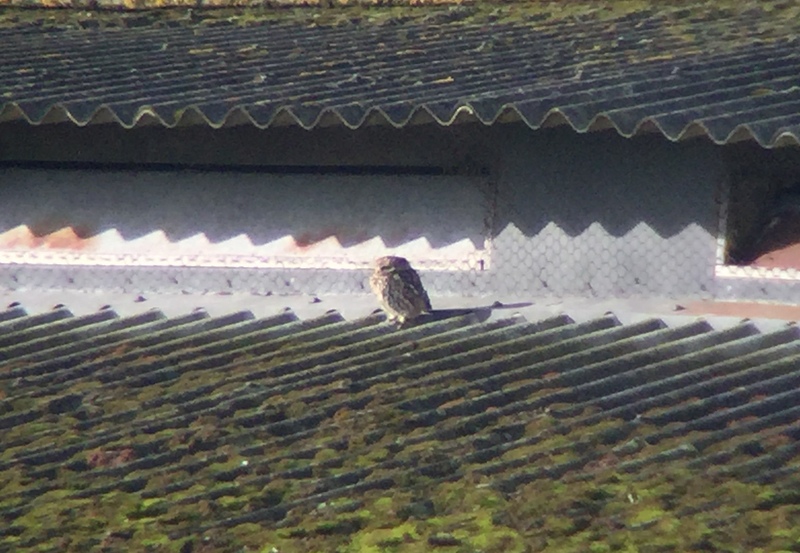 Little Owl – sunbathing on the roof of some old farm buildings
Little Owl – sunbathing on the roof of some old farm buildings
There were other things to look at here as well. A small group of Rooks were hanging around the farm buildings, as well as a couple of Red-legged Partridges. The latter flew up onto the roof as well, but the Little Owl seemed disinterested. A Goldfinch perched up on a dead burdock seedhead on the verge, looking stunning in the morning sunshine. In the field behind us, were several Lapwings and a few Common Gulls. A couple of suspicious looking clods of earth turned out to be Brown Hares, tucked down in the wind.
We drove on inland, round via a couple of other Little Owl sites, but it was perhaps a little windy for them today, with less shelter in the more exposed places. The morning was now getting on, so we decided to drive on towards Titchwell for a couple of hours until the owling could resume. We dropped down via Choseley and had a quick look for the Rough-legged Buzzards, but there was no sign in their favoured trees – they were probably sitting somewhere out of the wind. The Common Buzzards were up enjoying the wind though. From the road below Choseley barns we could see at least five in the air, but despite the best attempts at the others gathered there to turn them into something more interesting, there were just Common Buzzards out today.
The car park at Titchwell was very busy. We only had limited time today, as Owls were the main focus of the day, but we wanted to have a quick look round the reserve. The feeders in front of the visitor centre were packed with finches – Chaffinches, Greenfinches, Goldfinches – but as usual the ones round the other side held more variety.
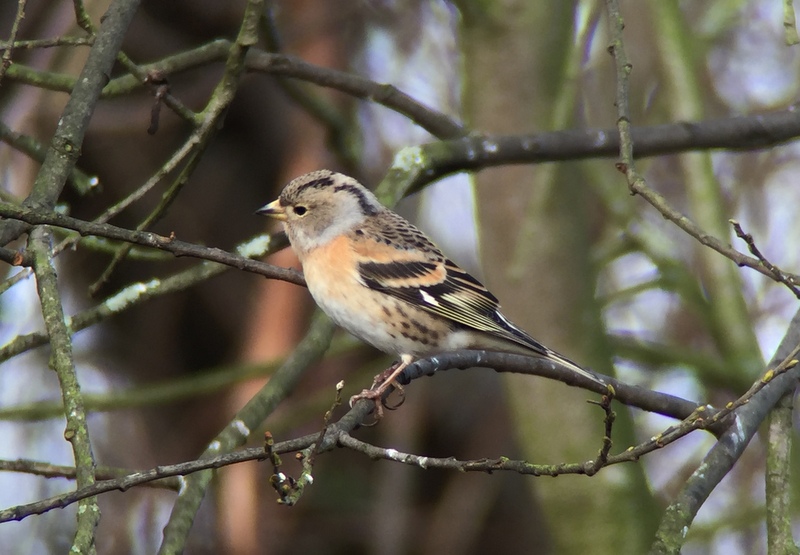 Brambling – a female around the feeders by the visitor centre
Brambling – a female around the feeders by the visitor centre
A female Brambling was perched up in the tree behind and dropped down onto the feeders briefly, grabbing a seed before disappearing back into the vegetation. A Siskin then appeared on the feeders as well – there are usually more in the alders, but it was windy in the tops of the trees today.
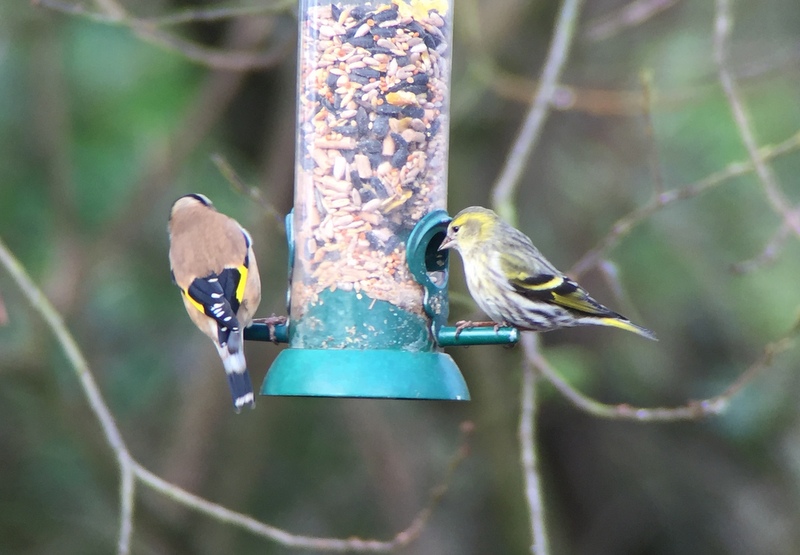 Siskin – one appeared on the feeders with the other finches
Siskin – one appeared on the feeders with the other finches
Then two male Bramblings dropped in. Much brighter orange below and on the shoulders than the female, and with increasingly black heads as the pale feather edges wear off to reveal the birds’ summer plumage.
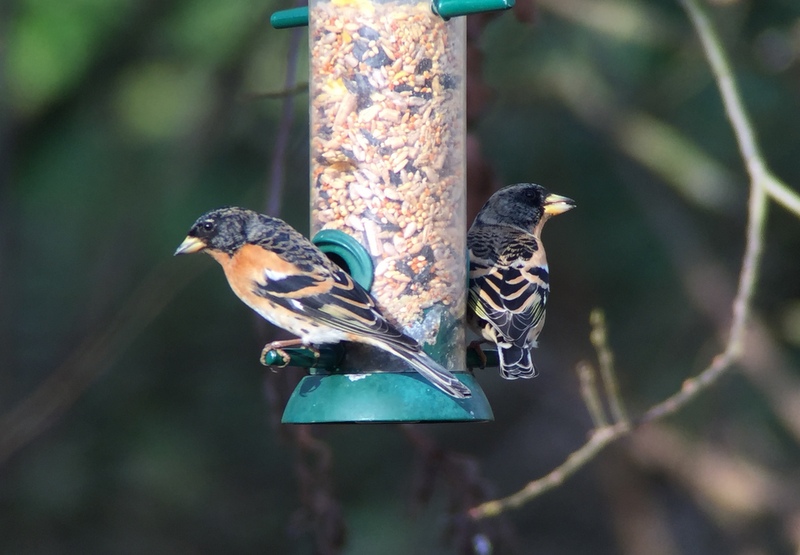 Brambling – two males dropped in to the feeders as well
Brambling – two males dropped in to the feeders as well
There was no sign of the Water Rail in the ditch on the way out, but lots of people were walking up and down, so we decided to have a better look on the way back. The grazing meadow ‘pool’ was rather windswept and deserted today apart from a couple of Lapwings. We headed for the shelter of Island Hide.
The freshmarsh is currently being drained to undergo management work and was very dry today. Consequently there are relatively few ducks on here now. There is a little bit of water still in the deeper parts towards the back, and the Teal were mostly around here or clustered on the far bank. Otherwise, there was just one pair of Shoveler. The Brent Geese which flew in from the saltmarsh towards Brancaster dropped down in the remaining pool at the back as well.
There are still a few waders on here, but the mud nearer the main path is starting to dry out, so they are also concentrated round the edges of the remaining water. There was a good sized flock of Dunlin on here, and still at least twenty Avocet. A couple of Black-tailed Godwits were a little closer and two Ringed Plovers were on one of the drier islands.
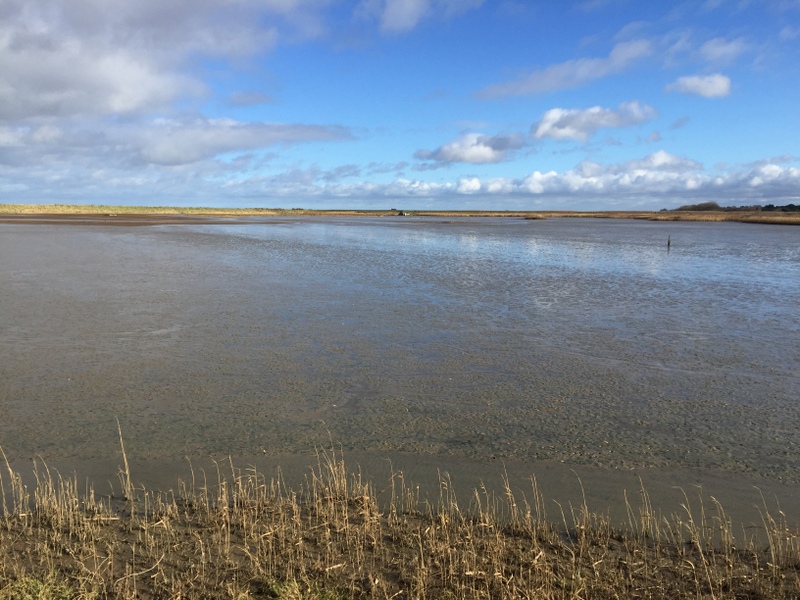 Titchwell freshmarsh – being drained currently for management work
Titchwell freshmarsh – being drained currently for management work
We had a quick look here and, with time pressing, quickly moved on. The Volunteer Marsh was a bit more productive. There are generally lots of Shelduck, Redshank and Curlew on here. We stopped in the shelter of the bank and had a scan. There were a few waders down in the near corner. The first we looked at were a couple of Knot, grey and dumpy with shortish bills, picking around the edge of one of the muddy channels.
 Knot – good views on the Volunteer Marsh
Knot – good views on the Volunteer Marsh
Just behind the Knot was a single Grey Plover, looking very smart in the winter sunshine. We watched it feeding – taking a couple of quick steps, stopping and looking down at the mud, occasionally picking at something it could see on the surface.
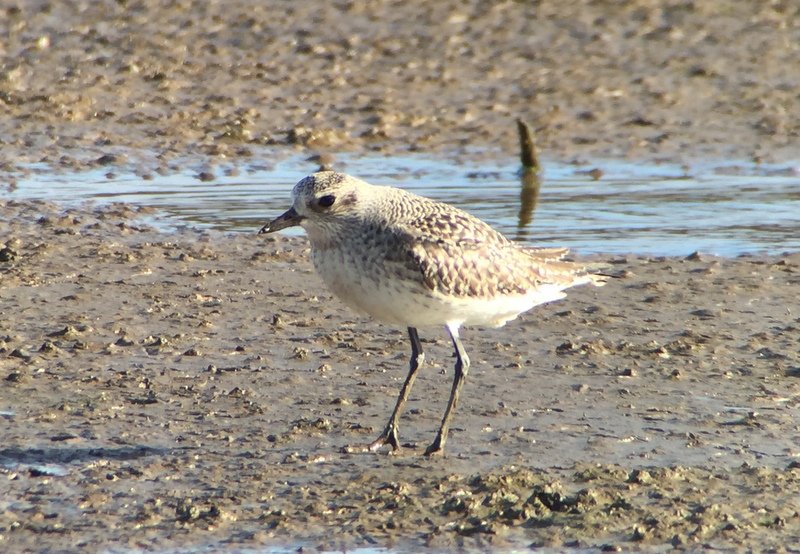 Grey Plover – also on the Volunteer Marsh
Grey Plover – also on the Volunteer Marsh
A couple of Ringed Plovers flew in and landed on the mud close by. Much smaller than the Grey Plover and very different looking, they share similarities in the way they feed. One of the two was attempting to display to the other, fanning its tail, but being blown along by the wind as it tried to do so.
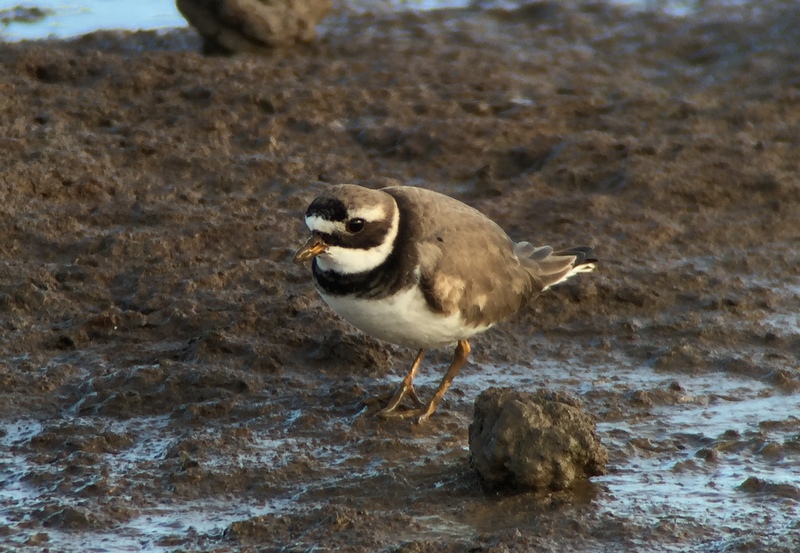 Ringed Plover – two flew in to the mud close to the main path
Ringed Plover – two flew in to the mud close to the main path
We had already seen a few Black-tailed Godwits more distantly on the freshmarsh, but there were two more feeding right by the main path at the far end of the Volunteer Marsh. This is regularly a great place to see them up close, so we stopped for a few minutes to admire them and watch them feeding.
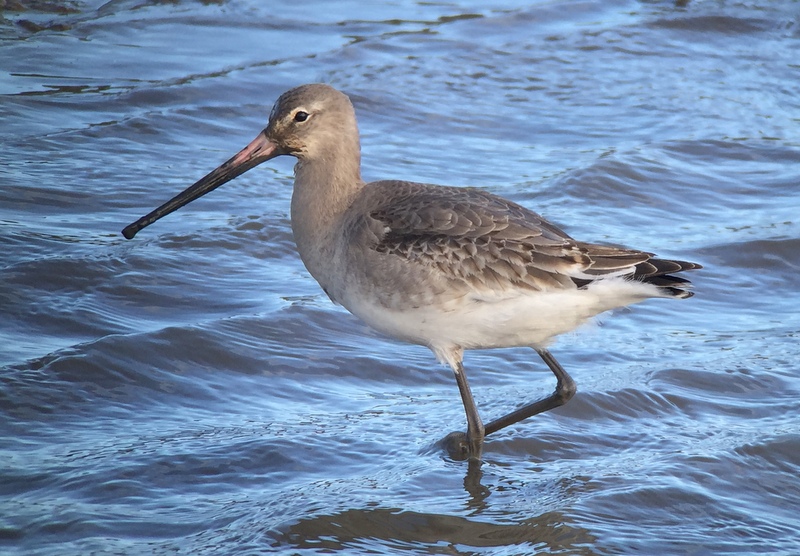 Black-tailed Godwit – feeding right next to the main path
Black-tailed Godwit – feeding right next to the main path
Out on the Tidal Pools, we could see a couple of female Goldeneye diving amongst the other ducks on the water. We had a look at the Wigeon grazing out on the edge of the saltmarsh behind. A Little Grebe surfaced right in front of us, before seeing us and diving again quickly. There were a few more Black-tailed Godwits, Redshanks and Grey Plovers on here but no other waders today.
A little further along, we stopped to admire the Pintail out on the water – there were several here upending, including some smart drakes. Another male further over out on one of the islands was asleep, but we could see his long pin-shaped tail.
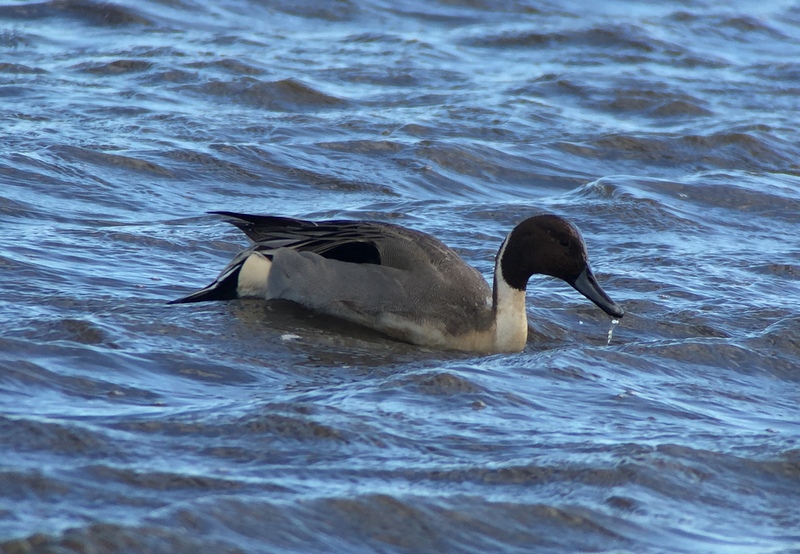 Pintail – one of several smart drakes on the Tidal Pools
Pintail – one of several smart drakes on the Tidal Pools
Out on the beach, the tide was out. The waders were rather distant, as we tucked oursleves into the shelter of the dunes rather than walk out across the sand. We could see lots of Oystercatcher, Dunlin, Turnstone and a few Bar-tailed Godwits. Close inshore, we could see a few Red-breasted Mergansers, including some smart drakes.
There were also 2-3 Common Scoter just offshore, so we had a good look at them too, a couple of females with their pale cheeks and a dowdy young male. Way off towards the Lincolnshire coast, out in the middle of the wash, we could just pick up the bulk of the wintering Common Scoter, like a dark smear across the sea. There are several thousand out here at the moment, but they are always a long way out these days. Eventually we found a slightly larger group on the sea off the beach, but they were also rather distant and hard to get a good look at as they rode in and out of the troughs on the swell. We could just make out at least one Velvet Scoter in with them, which flapped its wings briefly revealing the white flash in the secondaries, but it was all but impossible to get the rest of the group onto it unfortunately.
It was already later than planned, so we made our way quickly back. We had seen a single Bar-tailed Godwit on the Tidal Pools on our way out, but on our way back it was right next to the path. Even better, there was a Black-tailed Godwit with it. We had to stop to have a close look at the two side by side, the Bar-tailed Godwit noticeably smaller by comparison, shorter legged, with a very slightly upturned bill, paler and more buffy-coloured with more obvious streaking on the upperparts.
 Bar-tailed Godwit – right by the path on the Tidal Pools
Bar-tailed Godwit – right by the path on the Tidal Pools
When we got back almost to the visitor centre there were only two people on the main path and they were watching the Water Rail in its usual place. It was tucked down in the vegetation at first, but then came out onto the mud on the far side of the ditch in full view, giving us a great look as it probed its long red bill into the rotting leaves.
 Water Rail – showed very well on the way back
Water Rail – showed very well on the way back
After a late lunch, we started to work our way back along the coast. We swung inland at Choseley, but once again there was no sign of any Rough-legged Buzzards in the blustery wind, just several Common Buzzards still. A quick stop at Brancaster Staithe was more productive. The Red-necked Grebe was immediately on show, tucked in along the muddy edge of the channel just beyond the car park.
 Red-necked Grebe – showing well at Brancaster Staithe again
Red-necked Grebe – showing well at Brancaster Staithe again
There were also a few waders here as usual – Oystercatchers, Bar-tailed Godwits and several Turnstones running around between the cars in the car park. It was a bit exposed here in the wind and it was now owl time again, so we didn’t hang around too long.
There are lots of good places to look for Barn Owls along the coast road, particularly if you know where to look. The first site we went past was deserted, but we pulled into a layby at the second. In the process of saying “This is normally a good spot for Barn…” we turned to see one huddled down out of the wind on a gate in the hedge behind us, not 10 metres from the car. It was startled by our arrival and looked at us for a few seconds before disappearing behind the hedge. Our first Barn Owl of the afternoon and they were out and about.
We stopped at Holkham next to scan the grazing marshes. This is always a good place to look for Barn Owls and it had the added benefit of being sheltered from the wind by the Park behind us. A scan of the geese revealed a large flock of White-fronted Geese still, though a little distant again today over on the old fort.
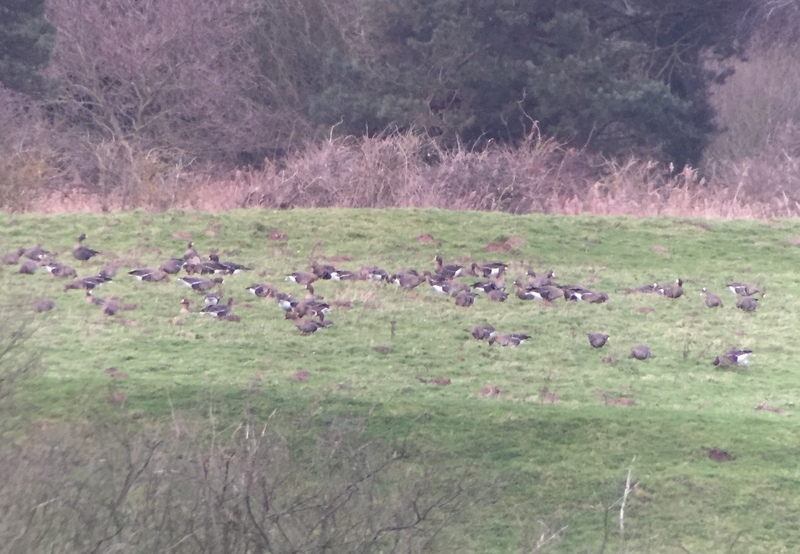 White-fronted Geese – still a good number at Holkham
White-fronted Geese – still a good number at Holkham
There were plenty of raptors up too, in the late afternoon. A Peregrine circled up over the trees, before stooping down towards one of the pools. A Common Buzzard landed in the top of a tree in front of us. There were lots of Marsh Harriers flying back and forth over the grazing marshes and three closer to us kept landing down on the grass. One of them, a female, was wing-tagged and near enough so we could read the tags ‘KX’. Ringed here in the nest in 2014, this bird has apparently not been seen since being sighted in Lincs in December 2014 – so a good resighting!
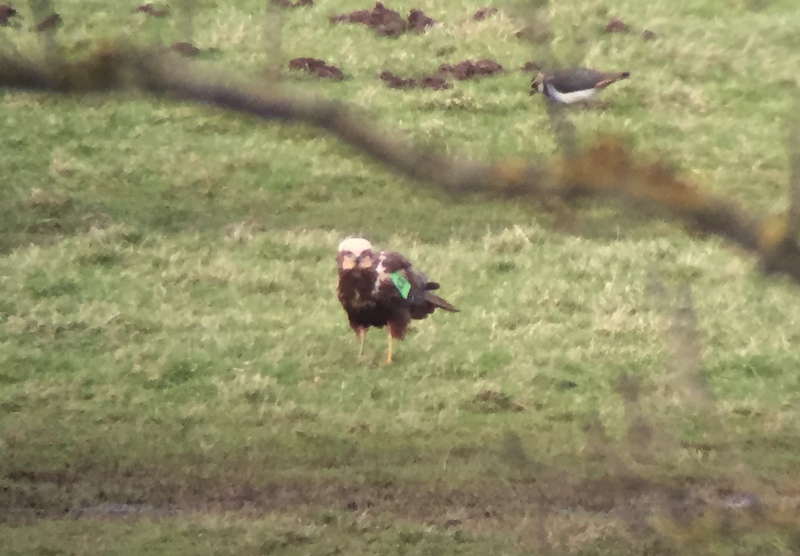 Marsh Harrier – with green wing tags ‘KX’
Marsh Harrier – with green wing tags ‘KX’
We could see a Barn Owl out hunting, distantly over the marshes. While we stood scanning, a second flew over along the bottom of the field in front of us, before flying over the reeds beyond and out onto the marshes too. We hadn’t seen the third Barn Owl before it appeared in front of us! It was working its way along the front grassy edge of the field and saw us standing in the gateway at the last minute, veering out over the field away from us. Yet more great views, we watched it flying round and even making another flypast along the same route – though this time we were ready for it, as it flew straight towards us.
We got back in the car and continued east, and suddenly yet another Barn Owl appeared from the trees and across the road in front of us. It seemed to be flying towards Lady Anne’s Drive, so we pulled in there for a scan. On the edge of the first field was a Barn Owl perched on the post. We got out of the car and it stayed put, allowing us stunning views of it through the scopes.
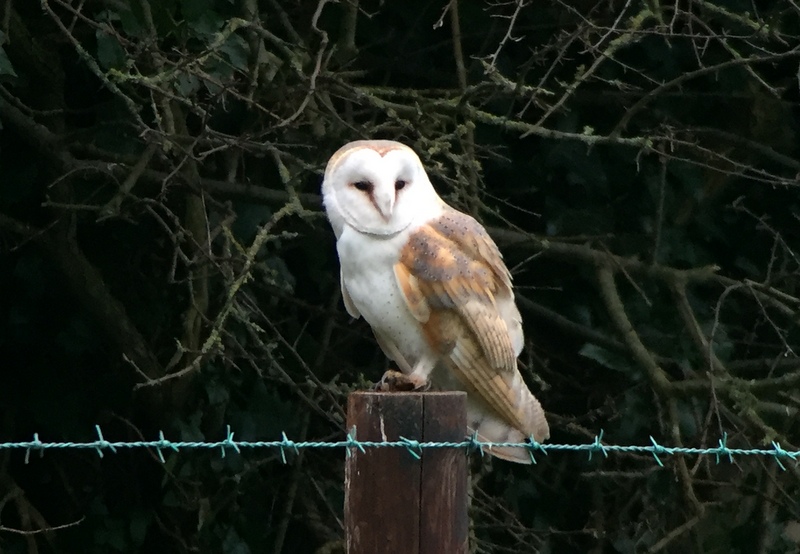 Barn Owl – perched on a post at Holkham
Barn Owl – perched on a post at Holkham
It looked noticeably darker than the one we had seen fly across the road and sure enough, that Barn Owl appeared on a post further along a few minutes later. It was hunting from the posts, flying between them, scanning the ground below. The first was also scanning the ground, but fluffed itself up and appeared to be going to sleep.
 Barn Owl – fluffed itself up and appeared to doze
Barn Owl – fluffed itself up and appeared to doze
We turned round to see yet another Barn Owl hunting over the fields behind us – three in view at once, our seventh of the afternoon and ninth of the day! When we turned back, the dozing Barn Owl had mysteriously disappeared and the paler one, presumably the male, flew off over the road into the trees, so we decided to move on.
We had a quick look at some other sites on the way, to see if we could find any more, but time was getting on and we had a date with a Tawny Owl. We drove into some woods and walked along a footpath through the trees. We could hear hooting even before we got to where we needed to be, much earlier than normal tonight. We hurried along to get into position and the Tawny Owl hooted again, from its roost deep in the ivy in a tree ahead of us. It was very windy in the treetops.
We waited patiently and caught a glimpse of the Tawny Owl as it dropped down out of its roost tree and landed on a branch over the path, back the way where we had come. Unfortunately it didn’t stay there very long and flew off into the wood the other side. We walked back and could hear it hooting. Then suddenly it flew back towards us and right over our heads – broad-rounded wings beating silently – disappearing back into the trees. It continued hooting but further over out of view. We decided to call it a night.
We were getting back into the car, when a Tawny Owl started hooting very close to us. Then a second started hooting back where we had come from, presumably the one we had seen earlier. Unfortunately, it was now getting too dark to see them. Still, it was a great way to end the day – with Tawny Owls hooting all round us.
















